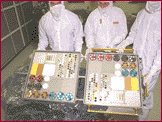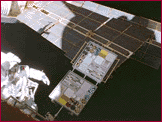




Objectives
The space environment has a strong degrading effect on some types of materials. Atomic oxygen, ultraviolet radiation, thermal cycling, hard vacuum, and induced contamination can all affect optical properties and mechanical integrity of spacecraft materials. The Mir Space Station provides a unique opportunity to study the natural space environment as well as the man-made environment, particularly contamination from orbiter dockings and venting activities around an active orbiting space station. POSA-I was proposed to study the Mir environment's effect on candidate materials for International Space Station (ISS) as well as state-of-the-art materials that might prove useful in future spacecraft design.
Shuttle-Mir Missions Approach
POSA-I was attached to the Docking Module and oriented so that one set of exposed samples faced the main core of the Mir Space Station while the opposite side faced space. Both sides had an 18 month exposure to the Docking Module and any attached hardware. In addition, the space facing side was periodically exposed to the Space Shuttle during dockings with Mir. During launch and retrieval the MEEP carrier was closed and sealed with a Viton O-ring. Each of the MEEP suitcase carriers could "breath" through a HEPA filter vent, so they were not hermetically sealed. This design protected the exposed samples from the Shuttle environment during launch, return, and most of the EVA operations.
Results
ISS Candidate Material Performance: ISS candidate materials chosen for exposure on POSA-1 included chromic acid anodized aluminum, sulfuric acid anodized aluminum, Z-93 white ceramic thermal control coating, and small 6" x 6" MLI blankets consistent with ISS design. Z93P on the Mir-facing side was very stable and remained nominally white. Z93P on the space-facing side was heavily contaminated with a yellow/tan appearance. Solar absorptance increased from about 0.16 to as much as 0.23 after only 18 months of exposure with 571 equivalent sun-hours of solar radiation. This is a concern since a solar absorptance value of 0.28 is predicted for Z93 after 10 years exposure on ISS, AND 0.30 is considered end of life.
State-of-the-Art Material Performance: State-of-the-art materials consisted of colored anodizes suitable for markers and astronaut visual aides. Postflight evaluation of red, yellow, blue and black colored anodizes showed them to be space-stable. Heavy contamination apparently had little effect on the colored anodizes, with no more than 3% increase in solar absorptance and negligible change in infrared emittance.
Samples of an innovative inorganic yellow marker coating (an alternative to colored anodizing) were tested. The Mir-facing samples showed negligible changes in optical properties while the space-facing side increased solar absorptance by 6.7% due to contamination.
POSA 1 contained a number of optical witness samples, including gold, platinum, iridium, and magnesium fluoride/aluminum mirrors. These samples were useful in ellipsometry and electron spectroscopy for chemical analysis of the space-side contamination. Transmission measurements of magnesium fluoride windows showed little change for the Mir-facing samples and a marked decrease in the UV and visible wavelengths for space-facing samples.
Samples of Triton Oxygen Resistant (TOR) film and Clear Oxygen Resistant (COR) film, which are atomic-oxygen resistant polymers films, were tested. These samples were both with and without silver/Inconel backing. Atomic oxygen fluence on the Mir-facing side was determined to be 7x1019 atoms/cm2 by mass and thickness loss of well-known polymer films such as Kapton, Lexan, and Teflon. Atomic oxygen fluence was not determined for the space-facing side due to the contamination.
Contamination was determined to be silicone offgassing converted to a silicate during exposure atomic oxygen and ultraviolet radiation. POSA-1 demonstrates the importance of utilizing materials on spacecraft that have low outgassing properties and keeping a large distance between contamination sensitive surfaces and any potential contamination source. It is imperative that contamination control be practiced in the form of good materials selection, thermal vacuum bake-out, clean room assembly, and attention to line-of-sight for contamination-sensitive materials, such as optics.
Publications Principal Investigators![]()
STS-76, NASA-2 - NASA-5, STS-86
All four MEEP experiments delivered to Mir by STS-76. They were successfully deployed on March 26th and 27th, 1996 during STS-76. The MEEP was successfully retrieved on October 1, 1997 during STS-86 mission and returned to the ground. The MEEP was exposed to the Mir external space environment for 18 months.
Contamination Observations: Contamination was detected on both sides of the POSA-1 experiment, with the space-facing side receiving the most deposition. The contamination was fairly uniform as would occur from a photodeposition process over days or weeks. The contamination also appeared to have directionality.
Wilkes DR, Carruth MR, "In-Situ Materials Experiments on the Mir Station," SPIE International Symposium on Optical Science, Engineering, and Instrumentation, San Diego, CA, July 1998.
Jim Zwiener
NASA/Marshall Space Flight Center
![]()
|
|
Curator:
Julie Oliveaux
Responsible NASA Official: John Uri |
Page last updated: 07/16/1999
.gif)